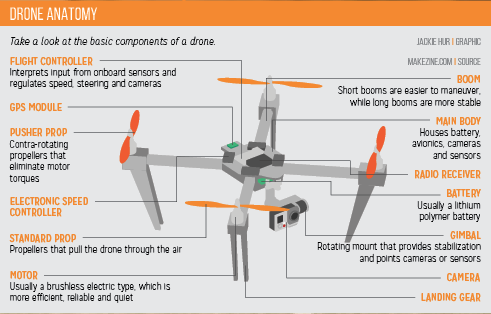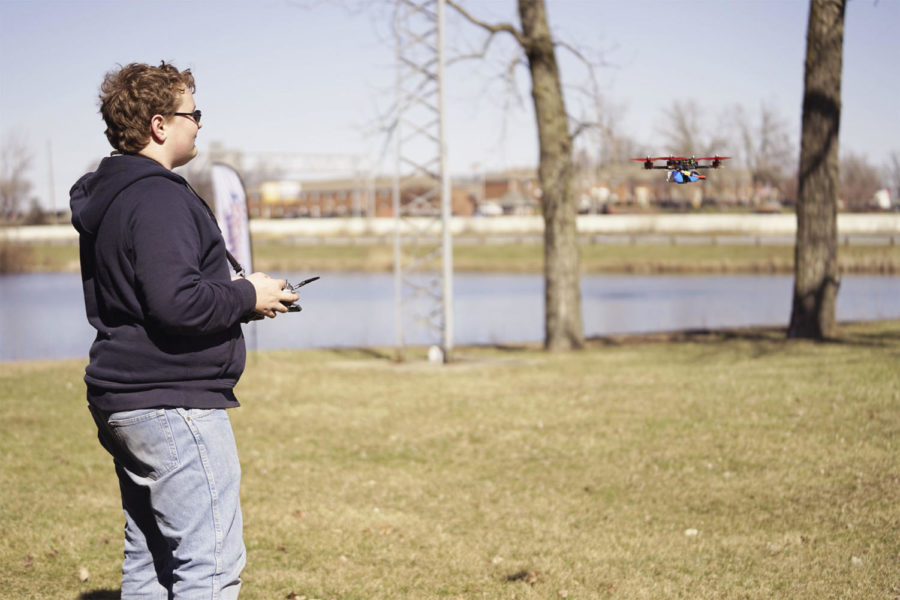On a sunny day, a group of students walk to a park with sets of high-powered drones. Sophomore Abraham Levine, nervously puts his drone down and starts to perform the usual checks before his first competitive drone race. As he sets his drone down on the pad, he puts on goggles connected directly to a camera attached to his drone. After a short countdown, a gust of wind and the sound of motors rotating at extreme speeds mark the beginning of the race as Levine flies his drone in a scramble for the finish line. Even though Levine finished in 7th place out of 15, with his fastest lap time being 16.61 seconds, he said the experience he gained made him better.
For the past couple of years, there has been a rise in the popularity of the use of personal drones and drone racing. From small local tournaments to the National Drone Racing League, both drone racing and freestyle flying are making a name for themselves. However, while the technology behind drones and drone racing competitions for personal use are relatively new, some students see drone racing and freestyling as viable hobbies for almost anybody to pick up quickly.
Nolan Featherstun, freestyle drone enthusiast and junior, said getting into building a drone is not as hard as it may seem.
“There are a couple ways to get into drone building,” Featherstun said. “One way is that people will buy a drone from Amazon, crash it and repair it enough times that they’ll know how it works and build their own. Another is just jumping right in, buying some parts and trying to build and fly one until it works.”
Featherstun also said the community is willing to help newer people in their drone endeavours.
“I got into drone building four years ago when I had met a guy who worked at Hobby Shop,” Featherstun said. “He told me about drones and from there on out, he turned out to be a mentor for me for a long time. He still mentors me to this day. There are a lot of people willing to help you out in the community.”
Levine said he agrees with Featherstun, and added he believes many students see building a drone as either difficult or dangerous, both of which are not true when handled properly.
“Drones are not as complex as some of the people I talk to make it out to be. There are lots of guides to making drones and other ways to learn how a drone works” Levine said. “I started learning how to build a drone after I kept breaking and repairing a pre-built one. Eventually, I knew what did what and started buying my own parts.”

Levine said flying a drone was similarly not as complicated as many make it out to be.
“Flying a drone does require a little practice,” Levine said. “However, for complete beginners, many of the pre-built ones that come in stores come with an accelerometer. (Accelerometers) help someone who is learning to fly move the drone around with more stability because the moment you let go of the joystick, the accelerometer automatically stops the drone from moving. ”
Nathan Willman, a drone owner and sophomore, said if a little fun is what someone’s looking for, drones are not hard to learn.
“Many people come to drones thinking that they will only have fun doing flips and stalls and all kinds of tricks,” Willman said. “I should know because I was one of those people. But just being able to control something up so high and have complete freedom of something like that is what is so fun about it. You don’t need to spend 30 hours just training to have fun.”
However, both Levine and Featherstun said building and flying for fun compared to competition or freestyle is completely different.
“The hardest part for me when I was trying to build my own drone
was having to constantly solder and repair parts,” Featherstun said. “It’s like riding a bike. The first few times you try it on your own, you are going to fail and break your drone, but eventually you get enough experience to know what to buy and what not to buy to build as close to a perfect drone as you can.”
“Flying is also hard to pick up when it comes to freestyle flying,” Featherstun said. “Many people spend lots of time in drone simulations practicing flying a drone because switching from an accelerometer to none takes some practice.”
Levine said the lack of experience when transitioning from just flying outside to competitive races is a time-consuming obstacle to overcome.
“The hardest part for me was my complete lack of experience when it came to personalizing my drone,” Levine said. “Where to buy the cheapest products, when it doesn’t matter what you buy, figuring out which brand names are the best, there are so many things that you have to figure out on your own because when you are racing your drone, you want to know and control exactly what it does. The money can add up if you aren’t careful.”
Willman said, “Many people see drone building as this oddball hobby that few do, but someone holds that controller in their hand and starts flying a drone for the first time, it’s an experience few can match.”































![What happened to theater etiquette? [opinion]](https://hilite.org/wp-content/uploads/2025/04/Entertainment-Perspective-Cover-1200x471.jpg)













































![Review: “The Immortal Soul Salvage Yard:” A criminally underrated poetry collection [MUSE]](https://hilite.org/wp-content/uploads/2025/03/71cju6TvqmL._AC_UF10001000_QL80_.jpg)
![Review: "Dog Man" is Unapologetically Chaotic [MUSE]](https://hilite.org/wp-content/uploads/2025/03/dogman-1200x700.jpg)
![Review: "Ne Zha 2": The WeChat family reunion I didn’t know I needed [MUSE]](https://hilite.org/wp-content/uploads/2025/03/unnamed-4.png)
![Review in Print: Maripaz Villar brings a delightfully unique style to the world of WEBTOON [MUSE]](https://hilite.org/wp-content/uploads/2023/12/maripazcover-1200x960.jpg)
![Review: “The Sword of Kaigen” is a masterpiece [MUSE]](https://hilite.org/wp-content/uploads/2023/11/Screenshot-2023-11-26-201051.png)
![Review: Gateron Oil Kings, great linear switches, okay price [MUSE]](https://hilite.org/wp-content/uploads/2023/11/Screenshot-2023-11-26-200553.png)
![Review: “A Haunting in Venice” is a significant improvement from other Agatha Christie adaptations [MUSE]](https://hilite.org/wp-content/uploads/2023/11/e7ee2938a6d422669771bce6d8088521.jpg)
![Review: A Thanksgiving story from elementary school, still just as interesting [MUSE]](https://hilite.org/wp-content/uploads/2023/11/Screenshot-2023-11-26-195514-987x1200.png)
![Review: "When I Fly Towards You", cute, uplifting youth drama [MUSE]](https://hilite.org/wp-content/uploads/2023/09/When-I-Fly-Towards-You-Chinese-drama.png)
![Postcards from Muse: Hawaii Travel Diary [MUSE]](https://hilite.org/wp-content/uploads/2023/09/My-project-1-1200x1200.jpg)
![Review: "Ladybug & Cat Noir: The Movie," departure from original show [MUSE]](https://hilite.org/wp-content/uploads/2023/09/Ladybug__Cat_Noir_-_The_Movie_poster.jpg)
![Review in Print: "Hidden Love" is the cute, uplifting drama everyone needs [MUSE]](https://hilite.org/wp-content/uploads/2023/09/hiddenlovecover-e1693597208225-1030x1200.png)
![Review in Print: "Heartstopper" is the heartwarming queer romance we all need [MUSE]](https://hilite.org/wp-content/uploads/2023/08/museheartstoppercover-1200x654.png)



